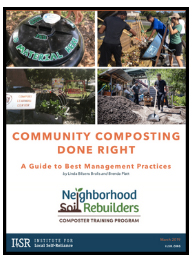Community Composting
Food waste in landfills emits the climate super pollutant methane, which heats the climate 84 times more than carbon dioxide.
Locals can fight climate change together and create a nutritious superfood for gardens and landscaping in their area with a central composting site.
These sites often support community gardens that supply fresh produce to the neighborhood.
Locals donate food waste to make compost for gardens and landscaping.
Residents may take home community garden produce grown with the compost.
Community gardens help food desert areas with no nearby grocery stores.
Community compost sites may give classes and free bins for backyard composting.
Things to consider when starting a community composting site:
- Urban farms and community gardens may be great site locations.
- Cities and counties may assist community gardens.
- Reach out to neighborhood associations.
- Promote the project on social media.
- Survey the community to see who’s interested in donating food waste or volunteering.
- Cafés, restaurants, and juice bars can donate clean, consistent food waste.
- Check with your local recycling coordinator and enforcement agency if you plan to accept from businesses.
The CalRecycle Community Composting for Green Spaces Grant Program provides funding from the Greenhouse Gas Reduction Fund to increase the number and capacity of small-scale composting programs in green spaces of disadvantaged and low-income communities.

Community Composting Done Right:
A Guide to Best Management Practices
Resources to help community composters’ process and site management.
Check with your local government
- Community projects that grow could qualify as state-regulated compost sites.
- Sites need local environmental health department permission if they:
- Hold over 100 cubic yards of compostable material or
- Have an area over 750 sq. ft.
- Find contact information in the Local Enforcement Agency Directory.
Pick-Up or Drop-Off
Donating businesses may need larger containers for their food waste.
Continually educate your donors on food waste to donate with a website, flyers, or stickers on collection containers.
Determine if you can legally pick-up donations or donors to drop off materials.
Tips for residents collecting food can be found on the I Recycle Smart page.
Pick-up system:
- Donors set their food waste containers at their curb, doorstep, or porch.
- Someone in your program can drive or bike around, emptying each container into a large collection bin.
- The convenience of a pick-up system usually means higher participation.
Drop-Off System:
Donors drop off their food waste at the composting site.
This requires:
- Set hours.
- Someone to monitor the drop-off site.
- Immediately cover food waste to reduce odor and discourage flies.
Additional Resources
- Los Angeles non-profit LA Community Garden Council
- San Diego Community Garden Network
- Santa Clara County operates a Master Composter program
- Composting and Food Waste Reduction (CFWR) Cooperative Agreements | USDA
- California Alliance for Community Composting (thecacc.org)
- Peels: Find a home for your food scraps, wherever you are
- Get started | MakeSoil
- Community Composting for Green Spaces Grant — California Climate Investments
For more information contact: Organic Materials, Organics@calrecycle.ca.gov
